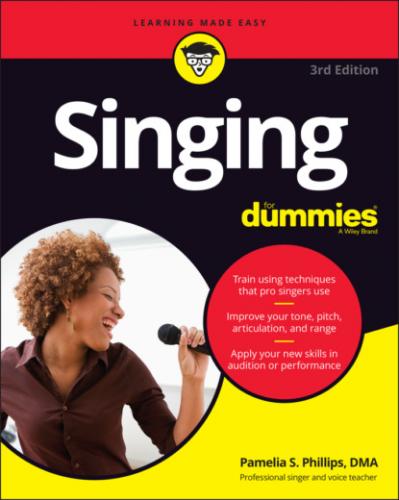10 Part 6: Appendixes Appendix A: Songs to Advance Your Technique Beginner Songs for Any Voice Type or Gender Intermediate Songs from Various Styles for Any Voice Type or Gender Songs to Practice Technical Lessons for Any Voice Type or Gender Songs to Work on Range and Registers Songs for Working Mix, Belt, and Falsetto Appendix B: About the Online Tracks Recognizing What’s Available: The Track Listings Tackling Any Potential Issues
11 Index
List of Tables
1 Chapter 8TABLE 8-1 Exploring Back VowelsTABLE 8-2 Exploring Front Vowels
2 Chapter 9TABLE 9-1 Practicing D, T, L, N, S, and ZTABLE 9-2 Practicing THTABLE 9-3 Practicing G, NG, K, and QTABLE 9-4 Practicing P, B, M, W, and WHTABLE 9-5 Practicing F and VTABLE 9-6 Practicing SH, ZH, J, and CH
List of Illustrations
1 Chapter 1FIGURE 1-1: Locating notes on the staff.
2 Chapter 2FIGURE 2-1: Soprano range. FIGURE 2-2: Mezzo range. FIGURE 2-3: Tenor range. FIGURE 2-4: Bass range.
3 Chapter 3FIGURE 3-1: Ideal alignment of the skeleton.
4 Chapter 4FIGURE 4-1: Lip and tongue trills.
5 Chapter 5FIGURE 5-1: Bouncing the tongue and jaw.
6 Chapter 6FIGURE 6-1: Creating a legato line. FIGURE 6-2: Trilling a long legato line. FIGURE 6-3: Managing long phrases.
7 Chapter 8FIGURE 8-1: Back vowels. FIGURE 8-2: Alternating vowels for precise lip shapes. FIGURE 8-3: Front vowels. FIGURE 8-4: Arching the tongue while alternating vowels.
8 Chapter 9FIGURE 9-1: Singing tip consonants. FIGURE 9-2: Singing soft palate consonants. FIGURE 9-3: Singing lip consonants. FIGURE 9-4: Combining your consonants.
9 Chapter 11FIGURE 11-1: Female middle voice range. FIGURE 11-2: Male middle voice range. FIGURE 11-3: Taking it down. FIGURE 11-4: Descending by step. FIGURE 11-5: Gliding through the middle. FIGURE 11-6: Moving along the four in middle voice. FIGURE 11-7: Chest voice range for women. FIGURE 11-8:
